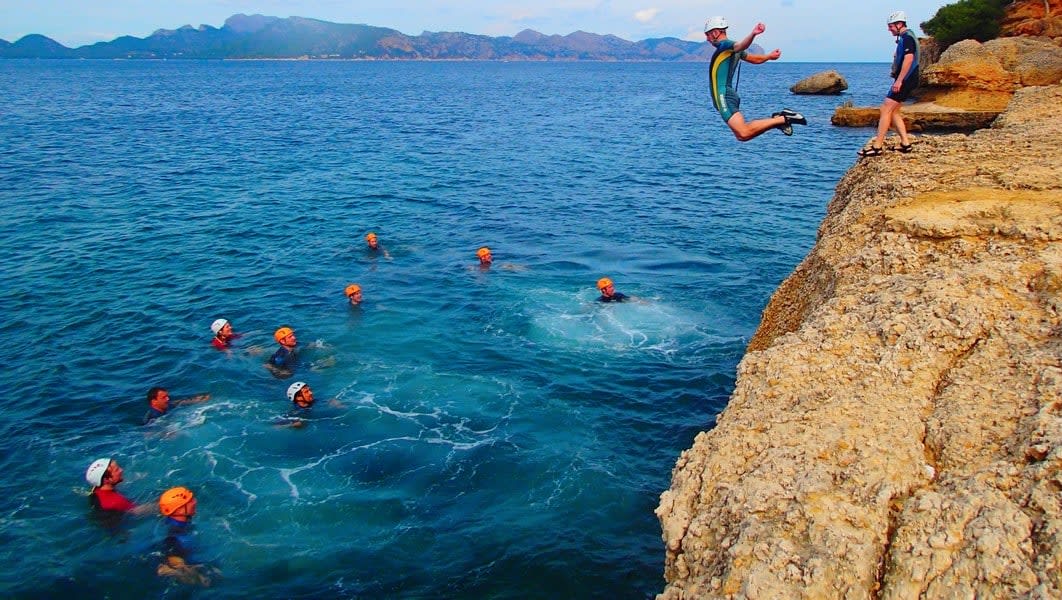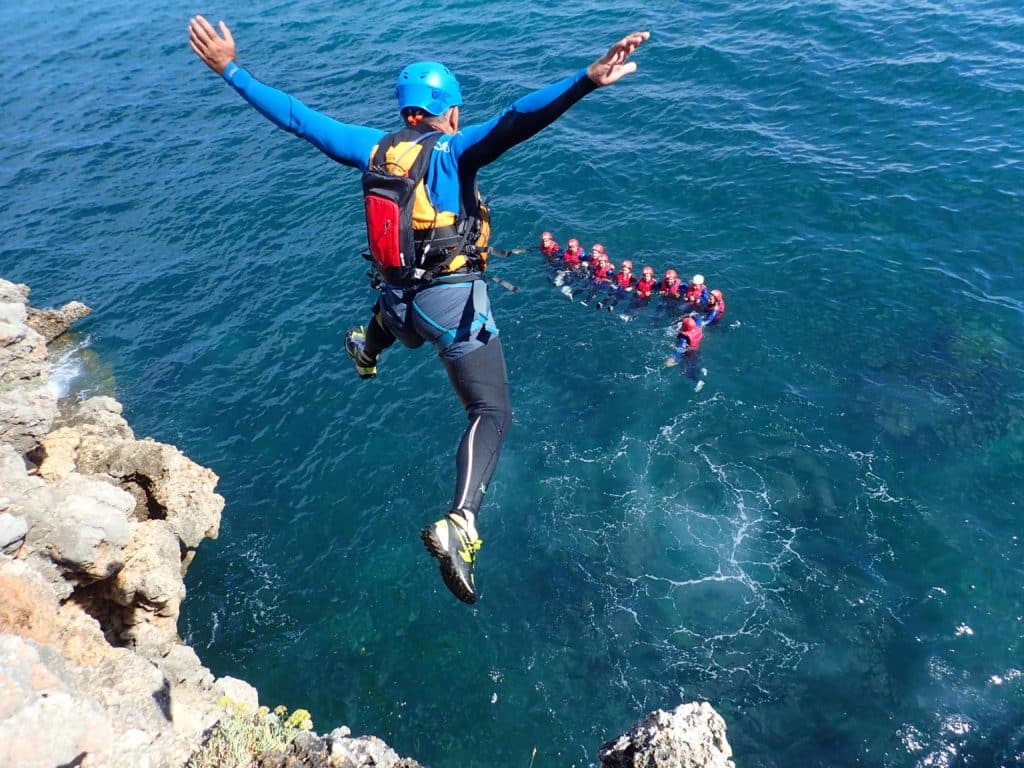The Complete Guide to Coasteering

If you have ever wondered what coasteering is and where to try it, read on to discover answers to all your questions. This complete guide to coasteering offers history, who can go, what it’s like and where you can try it.

History of coasteering
Thirty years ago, Welsh adventure-pioneers, and owners of the adventure company called TYF, came up with a great idea. The founders, Andy and Sarah Middleton were 4th generation adventurers and descendants of cavers in Yorkshire in the 1930s.
These adrenaline junkies loved outdoor sports of all kinds. They wanted to try canyoning but lived too far from any canyons. Their longing for something akin gave birth to a new sport – coasteering. With plenty of coastal areas nearby in Wales, it was the perfect place to start.
Also known as coastal canyoning, this relatively young sport has now spread past the borders of Wales, into England, and to many other European countries as well. Something this special and fun couldn’t be kept secret for long!
Coasteering is also very popular in regions where rivers and canyons get wet in the dry season, and where canyoning is not an option in Summer months – Palma de Mallorca and Greece, for example.

Why you should try coasteering
A coasteering adventure is an inexpensive, accessible, family-friendly and safe activity. Those that have already tried coasteering say they are big fans. Oftentimes, after completing their first trek, participants want to immediately go again!
People love coasteering because it combines various adventure sports all in one. Climbing, swimming, and abseiling on their own are very fun, physical activities. Therefore, when you combine all of these things people already like to do even individually, the enjoyment increases exponentially!
Another unique thing about coasteering is the access to sections of coastlines that would not be visible otherwise. You would never see caves under the cliffs by just standing above the coast looking down into the water. Coasteering is entirely immersive – you will essentially be one with the water and flow where it flows. You will discover special grottos, narrow coastal canyons and tidepools.
What people say about coasteering
An online periodical, Sudouest.fr, interviewed a group of coasteerers to see what they had to say about their experiences. Christian Massias, a 50-year-old participant, described the experience as, “… completely exotic and fabulous to discover the environment in this way, even if you have to (become more) comfortable in the rocks and the water.”
Another reason to try coasteering is that it’s likely to make you feel young again! A bonified fountain of youth. Coasteerers say they feel like kids again.
Do you remember that feeling of being a child and exploring, swimming just out of pure curiosity? Or, jumping into pools just for the sheer joy of it? Coasteering is such a joyful, youthful thing to do. It has even been described as rejuvenating.
Sudouest.fr also interviewed Rudy Verdier, a first-time coasteerer. Rudy reported that his group, “…had fun like teenagers, it (was) great, I loved it. You jump into the water, you get out, you climb, you explore a cave … we’re like children!” He exclaimed.
Coasteering is ultimately a great choice for those who like adventure, and just want to have fun- but, in a safe and controlled manner as well.
Who can go coasteering
Anyone can do this activity, with a few minor exceptions. Minimum ages for children vary based on location. Usually, children aged 8 and up are approved to join the fun. But in some locations in England for instance, the minimum age is 12. Several companies may offer introductory course options for younger children as well. Make sure to check the activity description for specific age requirements.
There are a few other exceptions to consider before coasteering. Firstly, It is recommended that participants feel comfortable swimming in general Experience swimming in waves is a plus as well, but not necessary. Secondly, confidence walking on uneven terrain and climbing around rocky areas should be fairly comfortable for you as well.
Guided tours are led by professionals who are oftentimes also expert climbers, kayakers, lifeguards, and canyoners. These guides know how water moves and behaves. They also know the more difficult areas that require a bit more strength, or technical maneuvering. Because of this, you won’t need to have advanced knowledge. Your guide will show you everything you need to do! They are skilled at adapting each section of the activity for each skill level.
There are also alternative routes available along the way if one section seems too scary or advanced. For example, a jump of 10 metres high, or abseiling, will be better suited for slightly older or more athletic participants.
What you will need for coasteering
When you book a guided coasteering activity, your guide will have almost all of the gear needed. For instance, they will provide helmets, neoprene wetsuits (for sites with colder waters) and life vests. You will need to bring your own swimwear, waterproof footwear, towel and camera if desired (Pictures will be amazing so don’t forget the GoPro!). For locations with warmer waters and weather, it is advised to bring water, sunglasses and sunscreen as well.
Depending on the type of tour, the instructors may also give you a harness for rock climbing, abseiling (rappelling down rock-faces) and possibly zip-lining.
Not all activities at your destination will include zip-lining or abseiling. Coasteering is designed specially to navigate each unique coastline’s features. For example, if you are visiting the Spanish Balearic Island of Palma de Mallorca, there will be a zip-lining portion of the tour.
What you will do to prepare for coasteering
Put simply, you will have FUN! Once you arrive at the tour guide/ instructor centre, you will fill out forms and waivers, and confirm whether you can indeed swim, the ages of your group members, and so forth.
Next, the staff will begin to get everyone fitted in their gear. Helmets need to be sized correctly, wetsuits need to be the right size as well. The instructors will then fit you in harnesses if applicable.
After everyone is suited up, the instructor will give a 30-minute, introductory brief regarding safety precautions, and what to expect during the activity. The average time for one coasteering session is about 3 hours and around 800 metres in length.
From there, the group will depart for the coast. Usually, the centre is only a 5-10 minute walk from the coast, so you won’t tire yourself out trying to get to the starting point!
I’m on the coast, now what?
What happens next is entirely dependent on the coastline, your tour, your group, and what the instructor has planned. You may start with a cliff jump (or alternate route of descent). Abseiling (rappelling) is quite common as you make your way down the cliffs, and then begin to swim to the next point with your group.
As you traverse the cliffs, you will alternate between the following activities:
- Swimming
- Rock climbing
- Jumping
- Abseiling
- Canyoning
- Sliding
- Exploring caves
- Exploring grottos
- Exploring tide pools
- Occasionally, you may even be greeted by seals!
No matter what order the adventure occurs in, it will unquestionably be amazing. Not to mention a great workout!
Lastly, coasteering offers opportunities for dazzling, adventurous photos to remember your trip by (and to post to Instagram!)
Photo Credit: Capital.fr
Where you can go coasteering
If you are lucky enough to live near the coast or have travelled somewhere along the sea, you know how breathtaking it can be when the salty ocean waves meet the land.
While all coastlines are stunning, some are not ideal for coasteering. For instance, it’s not recommended you try coasteering on the Cliffs of Moher in Ireland. Those may be better enjoyed a few feet back from the edge unless you really enjoy hospital stays!
Other coasts, such as some in the South of France, are not ideal either. While they don’t tower 214 metres (or 702 ft) above the ocean the way the Cliffs of Moher do, the rocky coast is not solid enough. Climbing, descending, and even standing on these cliffs can cause them to crumble.
Also important are the waters below. Deep, calm waters are ideal and safe. They make for stress-free jumps and enjoyable swimming. In addition to the crumbly cliffs, the waves in southern France are often much rougher and generally not as much fun to go coasteering in.
Luckily, there are many places that are lovely to go coasteering. The birthplace of Coasteering, for instance, Pembrokeshire.
Pembrokeshire, Wales
As the birthplace of this sport, coasteering excursions in Pembrokeshire are simply amazing. Wales is known for some of the most enchanting coastlines in the world, so it’s no wonder adventurers wanted to find some way to explore it! For more epic spots in the UK for coasteering, check out this article on the Top 5 Best Coasteering destinations in the UK!
Lisbon, Portugal
Portugal is known for offering an abundance of outdoor fun to visitors on vacation. The beautiful coastline of Lisbon is another idyllic spot for coasteering. With the old town nearby, just a short drive and you can jump into the turquoise waters below with your friends!
Chania, Greece
The coastlines of Greece are world-famous for their incredibly deep, beautiful blue waters, white sand beach and cliffs, and traditional Greek architecture. Plus, the climate is ideal for splashing around in the water and getting a tan! It’s certainly an unforgettable and ideal place to go coasteering in Greece.
Happy coasteering!
There you have it, the complete guide to coasteering. Hopefully, you are convinced of the amazing adventure coasteering can offer you. There are certainly more than just these three places to try it as well. Be sure to check all of our coasteering articles, including the Top 10 Best Spots to go Coasteering in all of Europe. You can also browse all of our coasteering activities on our website!